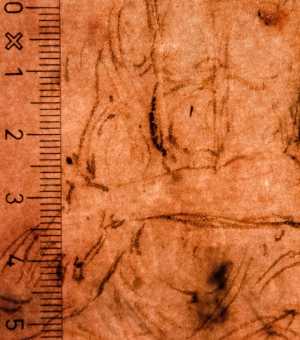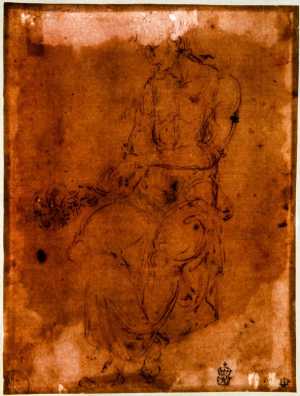Specifications
| Title | Seated Man with an Instrument (Astrolabe?) |
|---|---|
| Material and technique | Pen and brown ink, on paper prepared with red chalk |
| Object type |
Drawing
> Two-dimensional object
> Art object
|
| Location | This object is in storage |
| Dimensions |
Height 184 mm Width 138 mm |
|---|---|
| Artists |
Attributed to:
Donatello (Donato di Niccolò di Betto dei Bardi)
: Andrea Mantegna Previously attributed: Giovanni Bellini |
| Accession number | I 367 (PK) |
| Credits | Loan Stichting Museum Boijmans Van Beuningen (former Koenigs collection), 1940 |
| Department | Drawings & Prints |
| Acquisition date | 1940 |
| Creation date | in circa 1440-1460 |
| Watermark | Small anchor in a circle, sumounted by a simple cross high above (44 x 19 mm, above the centre, on P4 of 6P, vH, folio sheet) [see image], no comparable watermarks (as regards circle diameter, 19 mm) in Briquet and Piccard Online, so probably very early [see image] |
| Inscriptions | '[...] stoforo in ferrari' (?)' (unclear, verso, a.r., pen and brown ink) |
| Collector | Collector / Franz Koenigs |
| Provenance | The collection of drawings (2638 sheets in 16 albums, this sheet in Album G, no. 38), formed by Padre Sebastiano Resta (1635-1714), Milan, for Giovanni Matteo Marchetti, bishop of Arezzo (L.2911 deest); John Lord Somers (L.2981, inv. 'g 38' (Pollaiolo, poss. confused with g 17 Donatello)*, acquired with the Marchetti Collection from Marchetti's cousin the Cavaliere Marchetti of Pistoia in 1710; Thomas Banks (1735-1805, L.2423), London; his daughter Lavinia Forster (1775-1858), London; presented to her son in law, the architect Ambrose Poynter in 1856; by inheritance to his son Sir Edward J. Poynter (1836-1916, L.874), London; his sale, London (Sotheby's) 24.04.1918, in lot 156 (Roman School, 16th century); Archibald G.B. Russell (1879-after 1955, L.2770a), London/Swanage; his sale, London (Sotheby's) 09.05.1929, lot 11, ill. (Giovanni Bellini, BP 900 to Beets); Art dealer Nicolaas Beets, Amsterdam; Franz W. Koenigs (1881-1941, L.1023a), Haarlem, acquired in 1929 (Giovanni Bellini); D.G. van Beuningen (1877-1955), Rotterdam, acquired with the Koenigs Collection in 1940 and donated to Stichting Museum Boijmans Van Beuningen |
| Exhibitions | London 1921, no. 82; Amsterdam 1929, no. 169; Amsterdam 1929, no. 169; Amsterdam 1934, no. 490; Rotterdam 1938-39, no. 40; Venice 1949, no. 132; Rotterdam 1952, no. 86; Paris/Rotterdam/Haarlem 1962, no. 29; Rotterdam 2010 (coll 2 kw 6); Rotterdam (Circle Fra B.) 2016 (ex cat) |
| Internal exhibitions |
Tekeningen uit eigen bezit, 1400-1800 (1952) Italiaanse tekeningen in Nederlands bezit (1962) De Collectie Twee - wissel VI, Prenten & Tekeningen (2010) Rondom Fra Bartolommeo (2016) |
| Research |
Show research Italian Drawings 1400-1600 |
| Literature | London 1921, no. 82 (Giov. Bellini); Borenius 1923, p. 5; Von Hadeln 1925 (1), ill. 66 (G. Bellini); Vasari Society 1920-35, vol. 7 (1926), ill. 3 (G. Bellini, influenced by Mantegna and Donatello); Parker 1927, pl. 39; Amsterdam 1929, no. 169; Amsterdam 1934, no. 490 (Bellini); Van Marle 1923-38, vol. 17 (1935), pp. 344-346 (Bellini, influenced by Mantegna); Dussler 1935, p. 160 (not Bellini); Rotterdam 1938-39, no. 40 (G. Bellini); Tietze/Tietze-Conrat 1944, no. A 304, pl 186.3 (not Bellini, Tuscan 15th c); Dussler 1949, p. 83 (uncertain, Bellini?, after Donatello?); Fiocco 1949, p. 44 (Bellini, Tuscan influence); Venice 1949, no. 132 (Bellini); Degenhart 1950 (3), p. 27; Haverkamp Begemann 1952, no. 86; Haverkamp Begemann 1957, no. 35, ill. (early Bellini?); Paris/Rotterdam/Haarlem 1962, no. 29, pl. 27 (Bellini); Degenhart/Schmitt 1968, vol I-2, p. 360, no. 266, vol I-4, pl 257a (Donatello); White 1969, p. 434; Robertson 1968, p. 27; Clark 1970, pp. 262-263, ill. 5; Salvini 1972, pp. 346-347; Detroit-Fort Worth 1985, pp. 143-145 (follower of Donatello in his Paduan years); Van den Akker 1991, pp. 115, 118-119, fig. 192 (as attr. to Donatello, early 1450s); Goldner 1994, pp. 371-372, ill. 8 (Mantegna); Goldner 2019, p. 239, fig. 3 (Donatello) |
| Material | |
| Object | |
| Technique |
Prepare
> Prepared
> Shaping techniques
> General technique
> Technique
> Material and technique
Prepare
> Prepared
> Shaping techniques
> General technique
> Technique
> Material and technique
|
| Geographical origin | Italy > Southern Europe > Europe |
| Place of manufacture | Venice > Veneto region > Italy > Southern Europe > Europe |
Do you have corrections or additional information about this work? Please, send us a message


























